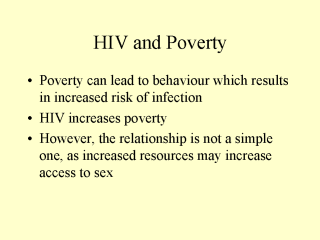 |
The cruel
paradox of the situation is that it is usually the poorest in society who are most
vulnerable to HIV/AIDS. They are least able to cope with an increased demand on, and
ultimate reduction in resources, which increases poverty and therefore vulnerability and
susceptibility to further infections. Poor people are often unable to purchase condoms or
afford basic medical care to treat sexually transmitted diseases (STDs), thereby
increasing the risk of HIV transmission. Poverty may drive women into prostitution and men
to become migrant labourers. However, the link between HIV/AIDS and poverty is more
complex than this. For example, ‘relative wealth’ in a community can also render
individuals more susceptible to the disease, as they can afford to pay prostitutes for
sex, and/or often have multiple sexual partners. |
